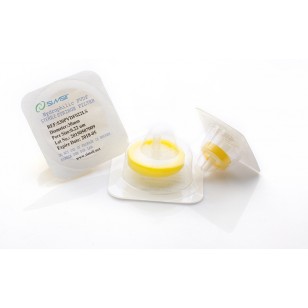For filtration of aggressive solvents and HPLC samples, PVDF syringe filters are considered as the best option. These filters with Polyvinylidene Difluoride membrane are ideally used for amino acid analysis and protein sequencing of proteins. These membranes are available as both hydrophilic and hydrophobic. If you are using hydrophobic membranes, they must be pre-wetted with methanol or ethanol before immersing in the buffer.
The construction of PVDF filters includes an internal pre-filter along with a strong Polypropylene (PP) housing. This housing prevents contaminants from mixing with the sample. Also, it reduces the chances of leakages.

The Properties of PVDF Filters:
PVDF filters have superior chemical compatibility, mechanical resistance, and low extractable. In these filters, the maximum allowed housing pressure is 150 psi. It enhances the speed of filtration. These filters are resistant to high temperature due to their high-grade material. They have exceptional flow rate and temperature stability. The broad chemical compatibility of PVDF membranes makes them ideal for filtration of general biological samples and solvent-based proteins, alcohols, peptides, aqueous samples, and tissue culture media. For better efficiency, you can autoclave them at 121 degrees for 20 minutes. They have Female Leur Lok inlet and Male Leur Slip outlet for preventing leakages and to ensure tight connection.
The Sizing of PVDF Filters:
For proper filtration of particles, you need to find the filters in an appropriate size. You should carefully select the diameter of filters. They are commonly available in sizes of 13mm, 25mm, and 30mm. Each of these has different capacity for holding up particles. Depending on the sample volume, you can choose the right filter diameter. For instance, 13mm diameter can be used for 1-10 ml of sample. Similarly, 25 mm PVDF syringe filters can be used for a sample volume of 10-100 ml. They have a holdup volume of less than 100 ml.
Similarly, the pore size and filter area should also depend on the size of particles to be filtered. When looking to buy these filters, check these sizing parameters to choose the best product suited to your applications.
The Wide Application of PVDF Filters:
The sterilization of protein-containing solutions, media preservatives, and antibiotics can be best done using a PVDF filter. They are compatible with most of HPLC samples and aggressive chemicals. These filters are designed with an internal pre-filter and PP housing having an outer colored ring. This design makes them perfect for high solids applications as well. In fact, PVDF filters are widely used for western blotting process and detection of proteins having a high molecule weight.
These are the main specifications, properties, and applications of PVDF Syringe filters. You should prefer buying them from a company that follows stringent testing procedures and quality controls for manufacturing and supply of syringe filters.
For filtration of aggressive solvents and HPLC samples, PVDF syringe filters are considered as the best option. These filters with Polyvinylidene Difluoride membrane are ideally used for amino acid analysis and protein sequencing of proteins. These membranes are available as both hydrophilic and hydrophobic. If you are using hydrophobic membranes, they must be pre-wetted with methanol or ethanol before immersing in the buffer.
The construction of PVDF filters includes an internal pre-filter along with a strong Polypropylene (PP) housing. This housing prevents contaminants from mixing with the sample. Also, it reduces the chances of leakages.


